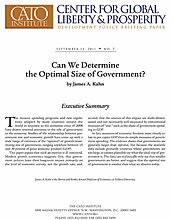This paper argues that such an exercise is ill conceived. Modern growth economics suggests, first, that government policies leave their long-term impact primarily on the level of economic activity, not the growth rate; and, second, that the sources of this impact are multi-dimensional and not necessarily well measured by conventional measures of “size,” such as the share of government spending in GDP.
In fact, measures of economic freedom more closely relate to per capita GDP than do simple measures of government spending. The evidence shows that governments are generally larger than optimal, but because the available data include primarily countries whose governments are too large, it cannot plausibly say what the ideal size of government is. The data can realistically only say that smaller governments are better, and suggest that the optimal size of government is smaller than what we observe today.

